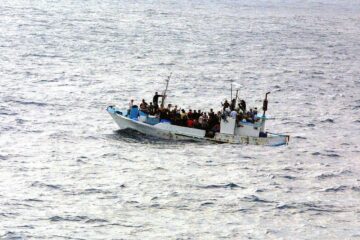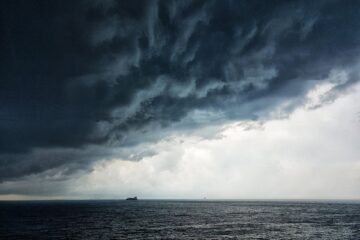![]()
Introduction:
It may be called the law of the seas, but includes all major forms of open water bodies that cover about 72% of the Earth’s surface. Life itself is said to have begun from the oceans. They have served humans in more ways than we know of, it is what began the era of discovery and adventure. Following the discovery of multiple communities across the high seas came the era of cross-country trade and commerce which we now refer to as globalisation.
The law of Seas not to be confused with maritime law, is a branch of International Public Law codified in the United Nations Convention of the Law of the Sea (UNCLOS), signed on December 10, 1982, and has been in effect since 1994. It is also known as the ‘Constitution of the Oceans’. Even the countries that have not ratified the treaty (such as the USA) still have to respect and follow it as the Customary International Law.
The UNCLOS takes about all the matters or issues that may arise at sea into cognizance including navigational rights, coastal water jurisdiction, sea lanes, ocean resources, conflict resolution etc. To handle the issues that may arise, many resolutions have been reached leading to the formation of the International Seabed Authority, set rules for coastal limits and sea boundaries and many other UN Commissions.
The Convention highlighted one very important part while codifying the laws. They explicitly provided that the oceans are open to all the states and that no state can dominate any part for itself. Thus, ensuring the freedom of the seas.
Organizations Administering the Protection of the Seas
The Regional Seas Conventions and Action Plans created by the United Nations Environment Program (UNEP) aims to promote the sustainable use of marine resources to protect the oceans. The UNEP was also the first to link terrestrial, freshwater, coastal and marine ecosystems in ‘The Global Programme of Action for the Protection of the Marine Environment from Land-based Activities’.[1]
The United Nations Educational, Scientific and Cultural Organisation (UNESCO) understands the importance of good background research with theoretical and practical knowledge. They set up the Intergovernmental Oceanographic Commission to promote the cooperation of countries in coordinating their research to better understand the oceans and seas of the world by creating a larger picture. This would help the world to better manage the resources and would help the UNCLOS better manage the countries in dispute.[2]
There also exists a whole different framework for matters relating to the ships and companies operating in the inhospitable waters around each pole. The International Code for Ships Operating in Polar Waters (Polar Code) covers a full range of topics such as the design and construction of the ship, the equipment, operations and training required for travellers including search and rescue methods. All of these are done keeping in mind the main target of environment protection.[3]
Even though the UNCLOS began as the coalition to create and manage the laws of the sea, it has no direct access in the implementation of these laws. The operational role has been divided amongst multiple other agencies of the UN like the International Maritime Organisation (IMO) to monitor and enforce certain provisions of the convention[4], the Intergovernmental International Whaling Commission and the International Seabed Authority (ISA) to organise regulate and control mineral-related activities beyond territorial limits.
The UNCLOS also established the International Tribunal for the Law of the Sea (ITLOS) consisting of a diverse panel of 21 judges situated in Hamburg, Germany. This tribunal adjudicates disputes regarding the interpretation and application of the convention. Most cases seen by the ITLOS have been between states about the shared boundaries of the ocean.[5]
International Maritime Organization (IMO)
Maritime law concerns issues amongst individuals, corporations and international organisations. The International Maritime Organisation is burdened with a task much greater than that, i.e. the implementation, the development, the codification and the regulation of the laws of the sea which includes maritime law. They are the highest authority for the development and maintenance of a generally accepted and effective legal framework for the shipping industry.[6]
The IMO has been known for implementing sustainable development via many regulations to reduce emissions from international shipping. These regulations include the ‘International Convention for the Prevention of Pollution from Ships’ and the ‘International Convention for the Prevention of Pollution of the Sea by Oil’.
Piracy too is a major threat to international trade via sea. A lot of routes are known to be major pirate hubs, the gulf Guinea and coast of Somalia for example. These pirates are a risk to not only the goods being transported but also every life on board as well as the environment if they decide to wreck the ship in the middle of the ocean. A few key routes cannot be avoided because of the huge added costs of taking the long cut. There exists an entire legal framework for the repression of Piracy under UNCLOS[7], for which the IMO and UN have adopted many additional resolutions[8]. The United Nations Office on Drugs and Crime (UNODC), through its Global Maritime Crime Programme (GMCP) also helps reduce Piracy as they combat Organised crime as a whole in Africa[9].
United Nations Convention on the Law of the Sea (UNCLOS)
The first conference of the UNCLOS began in 1956, in Geneva, Switzerland and resulted in four treaties being signed by 1958.
- Convention on the Territorial Sea and Contiguous Zone
- Convention on the Continental Shelf
- Convention on the High Seas
- Convention on Fishing and Conservation of Living Resources of the High Seas[10]
UNCLOS I was hence considered a success but UNCLOS II held in 1960 did not see any new agreements nor the formation of new treaties.
As a result of multiple disputes between countries about the extent of their territory towards the open seas came the Third United Nations Conference on the Law of the Sea in New York, 1973. It took the 160 participating nations nine years to reach a consensus. The consensus method was used instead of the usual majority vote method to avoid confederate states from swaying the negotiations. The Law of the Sea Convention came into force on 16th November 1994, a year after the 60th state ratified the treaty. As of June 2019, 168 countries have ratified this treaty.
This convention brought resolutions to many issues including navigation, transit regimes, continental shelves, jurisdiction over the seas, deep seabed mining, protection of the marine environment, scientific research, settlement of disputes and many more. They also set limits to the areas beyond the land that would belong to the country and to what extent they could exploit that area.[11]
Limit of Areas from Baseline
The Convention has carefully divided the water touching the land of any country into zones regulated by maritime law giving the country relative rights to exploit the area coming in their jurisdiction. The State has lesser rights over each zone as they move towards the high seas where no country has individual jurisdiction. Each zone has been named:
Internal Waters
Includes all the waterways on the landward side of the defined baseline. The coastal state is free to regulate and exploit this region. No foreign vessel has the right to enter these waters unless they have explicit permission and hence would have to adhere to the laws of that state while in internal waters.
Territorial Waters
The coastal state has further right to regulate the seas and exploit its resources out till 12 nautical miles or about 22 kilometres from the baseline. Foreign vessels have the right to ‘innocent passage’ through these waters. Innocent passage has been well defined by the convention as passing through without stopping and as quickly as possible. The convention also went forward as to define what is not innocent passage, i.e. fishing, polluting, weapons practice and spying. All underwater vessels must travel on the surface in these waters, clearly showing their flag. A country is free to shut off its territorial waters if they have reason to believe that it is prejudicial to their peace and security of the state.
Archipelagic Waters
For states consisting of many islands and interconnecting waters, the outermost points of the outermost islands will all be connected together to create the baseline of that country. The state will enjoy the same rights over these waters as if they were internal waters, except that foreign vehicles will have right to innocent passage over these waters like in territorial waters.[12]
Contiguous Zone
This is the zone 12 nautical miles further from the line of the territorial waters. In this zone, the state is allowed to enforce laws only in 4 fields, i.e. customs, taxation, immigration and pollution. These laws too will only be actionable if the contravention either began in or was about to occur in the state’s territorial waters.
Exclusive Economic Zones (EEZs)
The coastal state has solitary rights over all the natural resources to the extent of 200 nautical miles (i.e. 370 kilometres) into the sea. This term was introduced because of the rising disputes over exploitation rights. The EEZ starts from the baseline and hence the 24 nautical miles of territorial and contiguous zones are included in the 200. Foreign countries have the freedom to travel on and above these waters; they may even lay pipelines and cables through these waters subject to the coastal state’s regulations.
Continental Shelf
This gives the coastal state exclusive rights over even more of the ocean. The concept of the continental shelf is such that a nation may have right to the seabed even further than 200 nautical miles from the baseline until the natural prolongation ends. The exclusive rights over the continental shelf are limited to harvesting minerals and non-living materials from the seabed only, they do not regulate these waters, and they have no right over any organisms in the water. The limit set for a continental shelf is 350 nautical miles (i.e. 650 kilometres) from the baseline but not more than 100 nautical miles (i.e. 190 kilometres) further than the point at which the depth of the sea crosses 2500 meters.
High Seas
This is the area that lies beyond the zones described above if they do not belong to the EEZ of another state. The high seas are open to use by all states subject to the regulations set by the IMO. The seabed of the high seas is known as the International Seabed Area (aka “the area”) and the minerals on the area are said to be “the common heritage of all of mankind”. The exploitation of this heritage though is regulated thoroughly by the International Seabed Authority (ISA). If there is ever a resource extraction from the area by any state or private enterprise, a global mining enterprise or a similar authority will be established of the same size as one of the states or private enterprise. The fees and royalties from the State or Private enterprise as well as any profits made by the global enterprise will be distributed to developing countries.[13]
Conclusion
The United Nations has worked hard from the inception of the UNCLOS to keep the chances of a dispute over territorial waters at bay. They have come a long way in framing a constitution for the sea that the entire world abides by. Multiple organisations and programs have shown initiative to ensure the cooperation of all the nations in peaceful and defined use of the oceans.
It has already been working in the long run but certain disputes still exist between countries where the territorial waters, EEZs or the continental shelves overlap. Many such boundaries are agreed upon by the neighbouring countries usually by splitting it into equitable parts for each neighbour also keeping in mind special circumstances. The International Court of Justice, as well as specially constituted arbitration tribunals too, help solve such disputes.[14]
The rate at which the legal framework for seas is being developed, with such elaborate definitions and detailed descriptions of each concept, soon disputes about the seas will be a thing of the past. Especially because of the consensus method used by the UNCLOS to decide upon matters where every country can raise their issues and not be overpowered by ally nations who would otherwise dominate the negotiations to their benefit, and later cause disputes.
Overall, the law of the seas is a public international framework supported by more countries than not. Its main aim is the regulate and distribute the regulation of all the water bodies in the world and making sure the marine environment is not harmed. Thus, the exploitation rights given to each country come with the responsibility of sustainable development.
References:
Churchill, Robin R. Law of the Sea . n.d. 14 Sept 2020. <https://www.britannica.com/topic/Law-of-the-Sea>.
Depositary of Treaties. 2020. 14 Sept 2020. <https://treaties.un.org/>.
IMO in the UN. 24 Oct 2014. 14 Sept 2020. <http://www.imo.org/en/KnowledgeCentre/IMOAndTheUnitedNations/Pages/default.aspx>.
Intergovernmental Oceanographic Commission. 2013. 14 Sept 2020. <http://www.ioc-unesco.org/>.
Legal Framework for the Repression of Piracy Under UNCLOS. 09 Sept 2010. 14 Sept 2020. <https://www.un.org/depts/los/piracy/piracy_legal_framework.htm>.
Maritime crime and piracy. n.d. 14 Sept 2020. <https://www.unodc.org/unodc/en/piracy/index.html>.
Oceans and the Law of the Sea. n.d. 14 Sept 2020. <https://www.un.org/en/sections/issues-depth/oceans-and-law-sea/>.
Part IV Archipelagic States. n.d. 14 Sept 2020. <https://www.un.org/depts/los/convention_agreements/texts/unclos/closindx.htm>.
Shipping in Polar Waters. 2020. 14 Sept 2020. <http://www.imo.org/en/MediaCentre/HotTopics/polar/Pages/default.aspx>.
The Tribunal. n.d. 14 Sept 2020. <https://www.itlos.org/en/the-tribunal/>.
United Nations Convention on the Law of the Sea . 10 Dec 1982. 14 Sept 2020. <https://www.un.org/depts/los/convention_agreements/texts/unclos/closindx.htm>.
United Nations Documents on Piracy. 24 May 2012. 14 Sept 2020. <https://www.un.org/depts/los/piracy/piracy_documents.htm>.
[1] (Oceans and the Law of the Sea)
[2] (Intergovernmental Oceanographic Commission)
[3] (Shipping in Polar Waters)
[4] (IMO in the UN)
[5] (The Tribunal)
[6] (Oceans and the Law of the Sea)
[7] (Legal Framework for the Repression of Piracy Under UNCLOS)
[8] (United Nations Documents on Piracy)
[9] (Maritime crime and piracy)
[10] (Depositary of Treaties)
[11] (United Nations Convention on the Law of the Sea )
[12] (Part IV Archipelagic States)
[13] (Churchill)
[14] (Churchill)



0 Comments